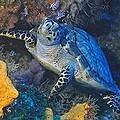 位於墨西哥東部的海港城市考祖梅(Cozumel),擁有敏感的珊瑚礁生態,是遊客如織的郵輪航線景點,卻也是地球上最瀕危的生物多樣性地域之一。上週,此地的郵輪業者、民間團體、政府部門相關首長與私部門代表,聯合簽訂一項保育協定,可望減輕當地每日上萬遊客對珊瑚礁生態的破壞。這份協定屬於「中美洲珊瑚礁旅遊計畫」(MARTI)一部份。
位於墨西哥東部的海港城市考祖梅(Cozumel),擁有敏感的珊瑚礁生態,是遊客如織的郵輪航線景點,卻也是地球上最瀕危的生物多樣性地域之一。上週,此地的郵輪業者、民間團體、政府部門相關首長與私部門代表,聯合簽訂一項保育協定,可望減輕當地每日上萬遊客對珊瑚礁生態的破壞。這份協定屬於「中美洲珊瑚礁旅遊計畫」(MARTI)一部份。
這項協定的主要策略是加強對遊客、旅遊業者、私人部門和當地社區的環境教育,讓他們意識到考祖梅自然資源的脆弱,例如玳瑁和珊瑚礁都處於瀕危狀態。
簽署協定的成員皆承諾改善當地的觀光設施,包括離島交通和廢棄物處理。他們都同意實施對卡祖梅珊瑚礁有利的保護措施,並制定法律和管理規範,以強制並長期執行。
身任MARTI國際保育組織顧問的馬圖斯(Seleni Matus)表示:「能聚集不同領域團體共同為保護考祖梅自然遺產這個目標努力,是很令人振奮的事!既然觀光是建立在環境之美,我們希望能在旅遊和保育間找到平衡。」他接著說道:「維護考祖梅自然資產不僅對全球生物多樣性深具意義,也有助於維持當地經濟體的健全穩定和居民福利。」
由下而上 展現參與式經營管理典範
這一系列行動方案的產生,是邀集各方權益相關者經過數次的「焦點團體」(focus groups)與討論工作坊而來的。這些討論會議參與者包括80多位郵輪業界領袖,由他們從郵輪觀光的觀點界定重要的環境議題,在討論中達成共識,並提出對應的合作方案。
像這類由郵輪業者共同擬定環境保育計畫的參與式程序,不僅是考祖梅創舉,也成為一種先例和典範,證明郵輪業者可以主動保護自然資源和生物多樣性。
這些郵輪業者還另組了一個跨部門組織,以協力執行保育協定中擬定的行動方案,這個組織在過去4個月已執行3項保育計畫,並證明確實達到改善成效,包括:
- 在郵輪上播放一捲30秒的宣導影片,鼓勵遊客儘可能在遊覽時減少觀光足跡。
- 在碼頭和購物商圈以照片展示考祖梅最原始純樸的景致。
- 在船上和陸上辦公室舉辦回收競賽。
接下來,他們將持續規劃舉辦環境教育宣導活動,這些活動對象不只針對郵輪乘客,也包括了工作人員和當地社區居民。
考祖梅海岸屬於「中美洲珊瑚礁系統」(Mesoamerican Barrier Reef System)的一部分,該生態系涵括墨西哥猶加敦半島南半端到宏都拉斯海灣離島群。這裡是西半球最長的珊瑚礁線,也是最瀕危的珊瑚礁生態系統之一。
To minimize the impact of up to 10,000 visitors a day on Cozumel's sensitive coral reef ecosystem, a conservation agreement was signed here last week by cruise industry leaders representing government, private sector, civil society, and the cruise lines.
Part of the Mesoamerican Reef Tourism Initiative, MARTI, the agreement is aimed at preserving some of the most endangered biodiversity on the planet living in the world's most visited cruise destination - Cozumel.
The agreement is intended to enhance environmental awareness and education of cruise ship passengers, tour operators, service providers and the local community about the area's fragile natural resources that include endangered hawksbill turtles and living coral reefs.
Parties to the agreement pledged to improve island management of tourism infrastructure, including improving island traffic and waste management.
They agreed to foster increased protection for Cozumel's reef system and promote consistent application and enforcement of laws and regulations.
"This is an exciting moment in time, bringing many different interests together to work on the common goal of protecting Cozumel's natural heritage in order to strike the right balance between tourism and conserving the environment it depends on," said Seleni Matus, MARTI Advisor for Conservation International.
"Maintaining the health of Cozumel's natural assets is vital not only to global biodiversity but also to the island's economic health and stability and the well-being of its inhabitants," Matus said.
These actions emerged from a series of focus groups and a multi-stakeholder workshop that brought together more than 80 cruise industry leaders to define high priority environmental issues related to cruise visitation, and reach consensus on collaborative actions for addressing them.
This participatory planning process for the cruise industry is the first of its kind in the region, making Cozumel a pioneer cruise destination in demonstrating its commitment to protecting its natural attractions and biodiversity.
Cruise industry leaders formed a multi-sector Working Group through which they will collaborate to implement the commitments outlined in the conservation agreement.
Over the past four months, this Working Group has implemented three conservation projects that are already demonstrating tangible improvements.
A newly produced 30-second educational video is shown to passengers onboard cruise ships encouraging them to leave a light footprint.
A photo exhibition highlighting Cozumel's most pristine areas is displayed near piers and shopping areas.
And a recycling campaign is now offered on board all tour boats and offices of onshore service providers.
Next steps include continuing to develop the environmental education campaign, not only for cruise ship passengers, but also for service providers and the local community.
Cozumel's coast is part of the Mesoamerican Barrier Reef System, which extends from the southern half of the Yucatan Peninsula to the Bay Islands of Honduras. It is the longest barrier reef in the Western Hemisphere and one of the world's most endangered reef systems.
全文及圖片詳見 ENS




